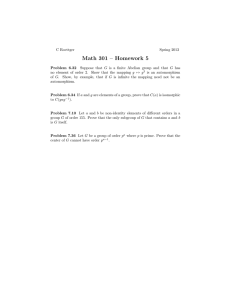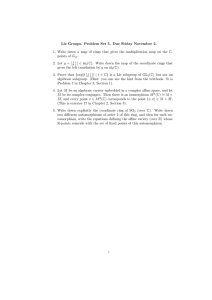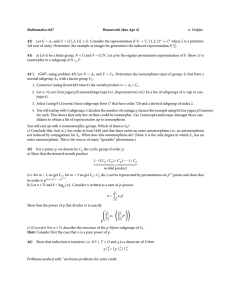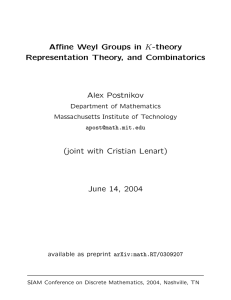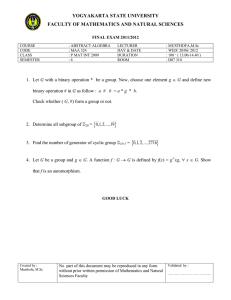2 The classical groups
advertisement
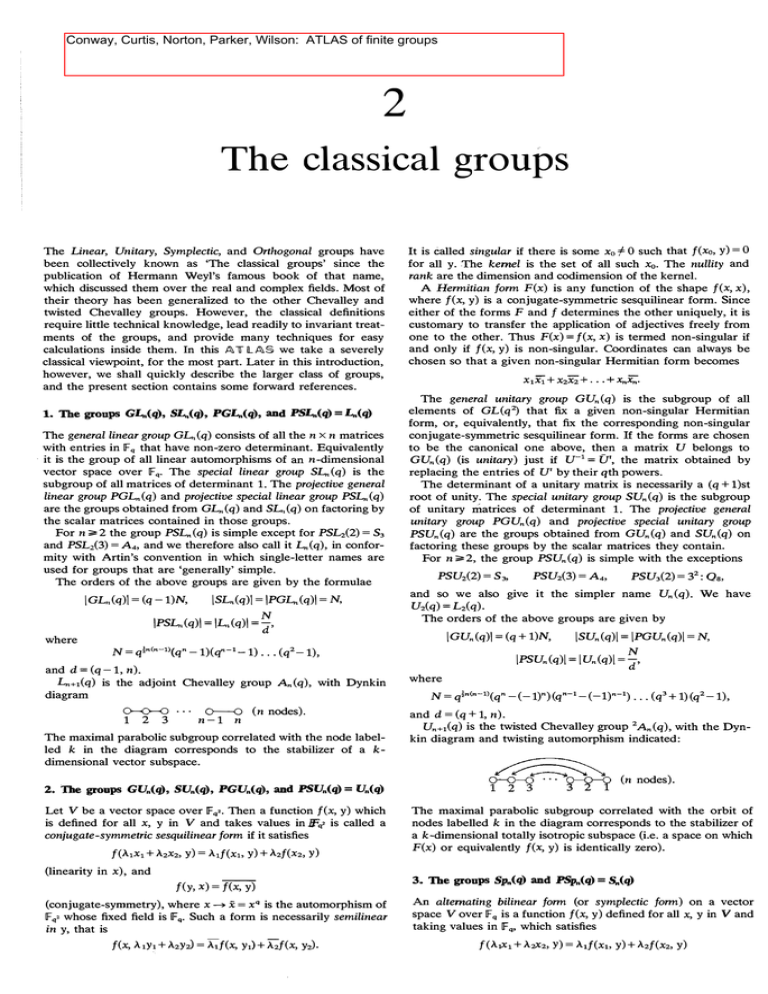
Conway, Curtis, Norton, Parker, Wilson: ATLAS of finite groups
2
The classical groups
The Linear, Unitary, Symplectic, and Orthogonal groups have
been collectively known as 'The classical groups' since the
publication of Hermann Weyl's famous book of that name,
which discussed them over the real and complex fields. Most of
their theory has been generalized to the other Chevalley and
twisted Chevalley groups. However, the classical definitions
require little technical knowledge, lead readily to invariant treat­
ments of the groups, and provide many techniques for easy
calculations inside them. In this A. lf 11.. A.§ we take a severely
classical viewpoint, for the most part. Later in this introduction,
however, we shall quickly describe the larger class of groups,
and the present section contains some forward references.
1. The groups GL.(q), SL,.(q), PGL.(q), and PSL.(q)
·
=
L.(q)
The general linear group GL.,(q) consists of all then x n matrices
with entries in IFq that have non-zero determinant. Equivalently
it is the group of all linear automorphisms of an n-dimensional
vector space over IFw The special linear group SL.,(q) is the
subgroup of all matrices of determinant 1 . The projective general
linear group PGL.,(q) and projective special linear group PSL.,(q)
are the groups obtained from GL.,(q) and SL.,(q) on factoring by
the scalar matrices contained in those groups.
For n;;,2 the group PSL.,(q) is simple except for PSL,(2)= S3
and PSI-,(3)=A., and we therefore also call it L.,(q), in confor­
mity with Artin's convention in which single-letter names are
used for groups that are 'generally' simple.
The orders of the above groups are given by the formulae
\GL.,(q)J =(q -1)N,
\SL.,(q)J = \PGL.,(q)J = N,
N
\PSL.,(q)J = \L.,(q)J = d'
where
It is called singular if there is some Xo f 0 such that f(x0,y) = 0
for all y. The kernel is the set of all such x0• The nullity and
rank are the dimension and codimension of the kernel.
A Hermitian form F(x) is any function of the shape f(x, x),
where f(x,y) is a conjugate-symmetric sesquilinear form. Since
either of the forms F and f determines the other uniquely, it is
customary to transfer the application of adjectives freely from
one to the other. Thus F(x) = f(x,x) is termed non-singular if
and only if f(x, y) is non-singular. Coordinates can always be
chosen so that a given non-singular Hermitian form becomes
x1 x1+XzX2 + .. . + X.X.·
The general unitary group au.(q) is the subgroup of all
elements of GL(q 2) that fix a given non-singular Hermitian
form, or, equivalently, that fix the corresponding non-singular
conjugate-symmetric sesquilinear form. If the forms are chosen
to be the canonical one above, then a matrix U belongs to
au.(q) (is unitary) just if u 1 = u, the matrix obtained by
replacing the entries of U' by their qth powers.
The determinant of a unitary matrix is necessarily a (q +1)st
root of unity. The special unitary group SU.(q) is the subgroup
of unitary rn.atrices of determinant 1. The projective general
unitary group PGU.(q) and projective special unitary group
PSU.(q) are the groups obtained from GU.(q) and SU.(q) on
factoring these groups by the scalar matrices they contain.
For n;;,2 , the group PSU.(q) is simple with the exceptions
-
PSU,(2)= S 3 ,
0-0-0
1
2
3
·
·
·
Q---0 (n nodes).
n-1
n
The maximal parabolic subgroup correlated with the node label­
led k in the diagram corresponds to the stabilizer of a k­
dimensional vector subspace.
2. The groups GU.(q), SU.(q), PGU.(q), and PSU.(q) = U.(q)
Let V be a vector space over IFq'· Then a function f(x,y) which
is defined for all x, y in V and takes values in lF.r is called a
conjugate-symmetric sesquilinear form if it satisfies
[(A1X1+AzXz,y) = A,f(x, y)+Azf(xz, Y)
(linearity in x), and
f(y, x)= f(x,y)
PSU3(2)= 32: Q8,
and so we also give it the simpler name U.(q). We have
U,(q) = L,(q).
The orders of the above groups are given by
\GU.(q)\
N = ql•<•-1\q"-1)(q"- 1-1) ... (q2-1),
and d = (q-1 ,n).
L.,+1(q) is the adjoint Chevalley group A.(q), with Dynkin
diagram
PSU2(3)=A.,
=
(q+1)N ,
\SU.(q)\ = \PGU.(q)\ = N,
N
\PSU.(q)\ = \U.(q)\ =d,
where
N = q!n(n-1l(q"
_
3
1
(-1)")(qn- _ (-1)"-1 ) ...(q +1)(q2-1),
and d=(q+1,n).
2
U.+1(q) is the twisted Chevalley group A.(q),with the Dyn­
kin diagram and twisting automorphism indicated:
�
o-o-o
1 2 3
·
· ·
o-o-o
3
2
1
(n nodes).
The maximal parabolic subgroup correlated with the orbit of
nodes labelled k in the diagram corresponds to the stabilizer of
a k-dimensional totally isotropic subspace (i.e. a space on which
F(x) or equivalently f(x, y) is identically zero).
3. The groups Sp.(q) and PSp.(q) = S.,(q)
(conjugate-symmetry), where x-'> x = x is the automorphism of
IFq' whose fixed field is IF"' Such a form is necessarily semilinear
in y, that is
An alternating bilinear form (or symplectic form) on a vector
space V over IFq is a function f(x, y) defined for all x, y in V and
taking values in IFq• which satisfies
f(x,A 1 Y1 +AzY2l = A,f(x,Y1l+A2 f(x, yz).
[(A1X1+A2X2 , Y)= A,f(x, y)+Azf(x2 ,y)
q
XI
THE CLASSICAL GROUPS
x ),
(linearity in
standard terms (rank, nullity, non-singular, isotropic), but always
and also
f(y, x) =-f(x, y)
f(x, x) = 0
and
Thus we define the
(skew-symmetry and alternation). It is automatically linear in
y
also (and so
bilinear).
The kernel of such a form is the
f(x, y) = 0 for all y, and the nullity
subspace of
and
f and F they apply.
rank of either f or F to be the
its kernel, and say that f or F is
being careful to state to which of
such that
x
of
rank
are the
f
dimension and codimension of its kernel. A form is called
non-singular if its nullity is zero. The rank of a symplectic form
is necessarily an even number, say 2m, and coordinates can be
chosen so that the form has the shape
nullity
and
dimension and codimension of
non-singular just when its nnllity is zero. A subspace is said to
(totally) isotropic for f if f(x, y) vanishes for all x, y in that
subspace, and (totally) isotropic forF if F(x) vanishes for all x in
the subspace. When the characteristic is not 2 our adjectives can
be freely transferred between f and F.
The Witt index of a quadratic form F is the greatest dimen­
sion of any totally isotropic subspace for F.It turns out that if
be
two non-singular quadratic forms on the same space over
symplectic group Sp.(q) is
of GL..(q) that preserve a
f(x, y ). Any such matrix
For an even number n = 2m, the
defined as the group of all elements
given non-singular symplectic form
necessarily has determinant
symplectic
PSp.(q) is
1,
groups coincide.
so that the 'general' and 'special'
The
Sp.(q) on
obtained from
and so we also call it
A, B, C, D
If
are
is obtained by subtracting
Hn ]. For
0 or 1.
a non­
singular form over a finite field the Witt defect is
The
general orthogonal group GO.(q, F) is
the subgroup of all
±1,
special orthogonal group SO.(q, F) is the subgroup of all
elements with determinant 1 . The projective general orthogonal
group PGO.(q, F) and projective special orthogonal group
PSO.(q, F) are the groups obtained from GO.(q, F) and
SO.(q, F) on factoring them by the groups of scalar matrices
2).
For
PSp.(2) = S6
have
Sz(q)=Lz(q).
(� �)
matrices, then
mxm
Witt defect
the Witt index from its largest possible value,
factoring it by the subgroup
PSp2(3)= A.,
S zm(q).We
have the same Witt index, then they are equivalent to scalar mul­
tiples of each other. The
elements ofGL,(q) that fix the particular non-singular quadratic
simple with the exceptions
PSpz(2)= S3,
q
projective symplectic group
of scalar matrices it contains (which has order at most
2m ;;;.2, PSp2m(q) is
IF
belongs to
form F. The determinant of such an element is necessarily
and the
they contain.
In general
PSO.(q, F) is not
simple. However, it has a certain
the symplectic group for the canonical symplectic form above
subgroup, specified precisely later, that is simple with finitely
just if
many exceptions when
A'C-C'A =0,
n;;;. 5. This subgroup, which is always of
2 in PSO.(q, F), we call 0. (q,F).
When n = 2m +1 is odd, all non-singular quadratic forms on a
space of dimension n over IFq have Witt index m and are
equivalent up to scalar factors. When n = 2m is even, there are
up to equivalence just two types of quadratic form, the plus type,
with Witt index m, and the minus type, with Witt index m - 1 .
index at most
B'D-D'B=O,
A 'D- C'B=I,
where M denotes a transposed matrix.
The orders of the above groups are given by
N
IPSpzm(q)l = ISzm(q)l =d,
where
(These statements make use of the finiteness of
d = (q-1 , 2).
S2m(q) is the adjoint
and
c.,(q)
Chevalley group
with Dynkin
diagram
0--0--0
1
2
3
·
·
� (m
m-2 m-1 m
·
nodes).
corresponds to the stabilizer of a
k
subspace
(that
is,
a
k -dimensional
space
on
totally iso­
which
f(x,
y)
is
identically zero).
4. The groups
and
O.(q)
symmetric bilinear form
f(x, y) defined for all x, y
on a space
in
V
V
over
IF
q
IF
q
which
f(JI.,x, + AzXz , y) = Jl..f(x, y) + Jl.zf(xz , y)
and also
f(y, x) = f(x, y)
(symmetry). It is then automatically linear in y.A
F( x)
on
V
IF
for which we have
q,
or
x...., x-
is a function
and taking values in
satisfies
x),
O.(q)
O�(q). This can be defined in terms of
the invariant called the spinor norm, when q is odd, or in terms
of the quasideterminant, when q is even. We define these below,
supposing n;;;. 3 (the groups are boring for n .;:;2).
A vector r in V for which F(r) f 0 gives rise to certain
elements of GO.(q,F) called reflections, defined by the formula
simple group
GO.(q), SO.(q), PGO.(q), PSO.(q),
A
(linearity in
When n is odd GO.(q), SO.(q), PGO.(q), PSO.(q), O.(q),
GO.(q, F) (etc.) for any non-singular F.
When n is even GO�(q), SO�(q), PGO�(q), PSO�(q), O�(q)
for either sign e = + or -, being the values of GO.(q, F) (etc.)
for a form F of plus type or minus type respectively.
being the values of
We now turn to the problem of determining the generally
The maximal parabolic group correlated with the node labelled
tropic
is a function
defined for
x
in
V
IFwl Accordingly,
we obtain only the following distinct families of groups:
m
m
m
N =q \q2 -1)(q2 -2_1) ... (qZ-1)
quadratic form
and taking values in
Fl:JI.x +fLY)= Jl. 2F(x)+ AfLf(x, y) + fL2 F(y)
for some symmetric bilinear form
f(x, y).
The kernel of f is the subspace of all x such that f(x, y) = 0 for
all y, and the kernel ofF is the set of all x in the kernel of f for
which also F(x)= 0.
When the characteristic is not 2 , F and f uniquely determine
f(x, r)
. r.
F(r)
O�(q) of index 1 or 2 in SO�(q).
PSO�(q) is the group we call
O�(q), which is usually simple. The a, PO notation was intro­
duced by Dieudonne, who defined O ��o be the commutator
subgroup of SO�(q), but we have changed the definition so as to
obtain the 'correct' groups (in the Chevalley sense) for small n.
For n;;;. 5 our groups agree with Dieudonne's.
When q is odd, �(q) is defined to be the set of all those g in
SO� (q) for which, when g is expressed in any way as the product
of reflections in vectors r, r 2 ,
, r, we have
We shall now define a group
The image
P�(q) of
this group in
•
F(r1) F(r2) .
•
•
•
....F(r,)
a square in
The function just defined is called the
takes values in
IF�/(IF�JZ.
where
IF�
IFw
spinor norm
of
g,
and
is the multiplicative group of
contains a bewildering variety of terminology adapted to de­
O�(q) has index 2 in SO�(q). It contains the scalar
m
matrix -1 just when n = 2m is even and (4, q - e)=4.
When q is even, then if n =2m +1 is odd, SO.(q)= GO.(q) is
isomorphic to the (usually simple) symplectic group Spzm(q), and
we define n.(q)= SO.(q). To obtain the isomorphism, observe
that the associated symmetric bilinear form f has a one­
scribe the more complicated situations that can hold in charac­
dimensional kernel, and yields a non-singular symplectic form
each other, so that the two kernels coincide. The literature
teristic
2.
This can be greatly simplified by using only a few
IF.-
on
Then
VIker(f).
xii
THE CLASSICAL GROUPS
led k,;; m-2 corresponds to the stabilizer of an isotropic k­
For arbi traryq, and n =2m even, we define the quasid
etermin­
ant of an element to be ( -1)", where k is the dimension of its
fixed space. Then for q odd this homomorphism agrees with the
determinant, and for q even we define 0� to be its kernel. The
quasideterminant can also be written as ( -1)0, where D is a
space for F. Those correlated with the nodes labelled m, and m2
correspond to stabilizers of members of the two families of
isotropic m-spaces for F.
02m(q) is the twisted Chevalley group 2D (q), with the Dyn­
m
kin diagram and twisting automorphism
polynomial invariant called the Dickson invariant, taking values
in IF •
2
·
An alternative definition of the quasideterminant is available.
When s= + there are two families of maYJmal isotropic sub­
1 2
spaces for F, two spaces being in the same family just if the
codimension of their intersection in either of them is even. Then
04(q)= L,(q2),
O;i(q)= L2(q)x L,(q),
O;;(q)= U .( q).
O,(q) = S.(q),
O�(q)= L.(q),
O,(q)= L,(q),
definition.
When n =2m +1 is odd, the groups have orders
The group
ISO"(q)l = IPGO"(q)l= IPSO"(q)l = N,
N =qm'(q2m -1)(q2m-2_1) . .. (q2-1)
5. Oassification of points and hyperplanes in orthogonal
spaces
+t(q) is the adjoint Chevalley group
2m
Bm (q), with Dynkin diagram
and d= (2,q-1). 0
·
·
·
09=0
m -1 m
On(q) is simple for n;;. 5, with the single exception
that 05(2) =S.(2) is isomorphic to the symmetric group S6•
O
I n(q)l = I Piln(q)l = I On(q)l = N/d,
3
1
classical groups, as follows:
families of m-dimensional isotropic spaces and can use the same
0-0-0
(m nodes).
For n,;; 6, the orthogonal groups are isomorphic to other
sion m -1, but if we extend the field to IF•', we obtain two
1 2
m
�
isotropic k-space for F.
the maximal isotropic spaces defined over IF• have dimen­
where
3 m
nodes labelled k,;; m -1 corresponds to the stabilizer of an
preserves each family or interchanges the two families. When
IGO"(q)l=dN,
m -1
A.!
- 2'o
.
The maximal parabolic subgroup correlated with the orbit of
the quasideterminant of an element is 1 or -1 according as it
e =-,
·
o-o-o
Let V be a space equipped with a non-singular quadratic form
F. Then for fields of odd characteristic many authors classify the
(m nodes).
vectors of V into three classes according as
The maximal parabolic subgroup correlated with the node label­
F(v)=O,
led k corresponds to the stabilizer of an isotropic k-space for F.
F(v) a non-zero square,
When n =2m is even, the groups have orders
IGO�(q)l =2N,
F(v) a non-square,
ISO�(q)l = IPG O�(q)l =2N/e,
IPSO�(q)l =2N/e 2,
since these correspond exactly to the three orbits of projective
IO�(q)l = N/e,
points under the orthogonal group of F.
In this A lf 1L A§ we prefer a different way of making these
IPO�(q)l = I On(q)l = N/d,
distinctions, which is independent of the choice of any particular
where
scalar multiple of the quadratic form F, and which does the
N =qm<m-tl (q"' _s)(q,.,_2_1)(q2m-4_1) . . . (q2_1)
correct thing in characteristic 2 . We say that a subspace H of
even dimension on which F is non-singular is of
plus type or
minus type according to the type of F when restricted to H, and
if H is the hyperplane perpendicular to a vector v , we apply the
same adjectives to v. Thus our version of the above classification
and d= (4,qm -s), e = (2,qm -s).
O'i: (q) is the adjoint Chevalley group D (q), with Dynkin
m
m
diagram
(
m,
o-o-o
1 2
3
m -
is
( m nodes).
m
vis ot r o pic (or null ),
v of plus type,
2
v of minus type.
The maximal parabolic subgroup correlated with the node label-
Table 2. Structures of classical groups
d
(n,q-1)
d.
d
(q-1xG) .d G.d
d
(
)
q+1
d. --XG
d
.d
G.d
d
Spn(q)
(2,q-1)=2
(2,q-1)=1
2.G
G
d
GO�(q)
(4,qm -s)=4
(4,qm -s)=2
(4,qm -s)=1
2 .G.22
2X G.2
G.2
2XG.2
G
d.G
G
PGUn(q) SU" (q) PSU" (q)= Un(q)
GUn(q)
(n,q+1)
(2,q-1) =2
(2,q-1) =1
PGL,.(q) SL,.(q) PS L,.(q)= L,.(q)
GL,.(q)
d.G
G
PSpn(q)= S
"(q)
G
G
PGO�(q) SO�(q) PSO�(q) O�(q) PO�(q)= O�(q)
G.22
G.2
G.2
G.2
G
2 .G.2
2XG
G.2
G.2
G
G.2
G
G.2
G.2
G
2.G
G
G
G
G
g}
n=2m
g}
n=2m +1
THE CLASSICAL GROUPS
which we employ in this A.lr D.. A.§ is rapidly gammg ground
6. The Cliftord algebra and the spin group
The
Clifford algebra
of F is the associative algebra generated
by the vectors of V with the relations x2=F(x), which imply
xy+yx=f(x,y). If V has basis
e, . . . ,e,,
Xlll
then the Clifford
algebra is 2" -dimensional, with basis consisting of the formal
products
amongst group theorists, there are still many people who write
Un(q2)
or
U(n, q2)
for what we call
Un(q).
Artin's 'single letter
for simple group' convention is not universally adopted, so that
many authors would use
GU.(q)
and
GOn(q).
times been used for
Un(q)
and
The notations
G2(q)
On(q) for what we call
E2(q) and E4(q) have some­
and F.(q).
Dickson's work has had a profound influence on group theory,
The vectors
r
with
F(r) 'f 0
generate a subgroup of the Clifford
algebra which is a central extension of the orthogonal group,
the vector
r
and his notations still have some currency, but are rapidly
becoming obsolete. Here is a brief dictionary:
in the Clifford algebra mapping to the negative of
the 'reflection in
r.
(Linear fractional)
When the ground field has characteristic 'f2,
(Hyperorthogonal)
this remark can be used to construct a proper double cover of
the orthogonal group, called the
G,
which is the appropriate
L,(q), U.(q), S.(q), O.(q).
There are many minor variations such as
q)= 02m+1(q)
F0 (2m, q)= 02m (q where e =± 1,
m
(Second orthogonal) S0(2m,q)= 02!(q) q == e modulo 4.
(First hypoabelian) FH(2m, q)= O�m(q)
•
(Second hypoabelian)
)}
SH(2m, q)= 02m(q)
Dickson's first orthogonal group is that associated with the
8. Other notations for the simple groups
L, (q)
{
q)=S2m (q)
F0(2m +1,
.
(F1rst orthogonal)
Table 2 describes the structure of all the groups mentioned, in
terms of the usually simple group
=
(Abelian linear) A(2m,
spin group.
7. Structure tables for the classical groups
one of
LF(n, q)=L,(q)
HO(n, q2) Un(q)
quadratic form
L,(IF )
q
or
L(n, q)
for
which should give little trouble. However, the reader
should be aware that although the 'smallest field' convention
xi+ x�+...+x�. His orthogonal groups are
defined only for odd
q.
q,
and his hypoabelian groups only for even
He uses the notation
ous group) for
GL,(q).
GLH(n, q)
(General Linear Homogene­
3
The Chevalley and twisted
Chevalley groups
finitely many cases its abstract universal cover is the correspond­
1. The untwisted groups
The Chevalley and twisted Chevalley groups include and neatly
ing universal Chevalley group.
In the standard notation, the complex Lie algebras are
generalize the classical families of linear, unitary, symplectic,
An
and orthogonal groups.
In the entries for individual groups in the A lr IL A§, we have
preferred to avoid the Chevalley notation, since it requires
considerable technical knowledge, and since most of the groups
we discuss also have classical definitions. The classical descrip­
C,
Dn
Gz
F4
E.
E,
Es
where to avoid repetitions we may demand that n ;a.l,2, 3, 4 for
A., B., C,, Dn respectively. The corresponding adjoint Cheval­
ley groups are denoted by
An(q),Bn(q), C,(q),Dn(q), Gz(q),F.(q), E.(q), E,(q), Es(q).
tions, when available, permit easy calculation, and lead readily
to the desired facts about subgroups, etc.
Bn
The corresponding Dynkin diagrams, which specify the structure
However, for a full understanding of the entire set of finite
simple groups, the Chevalley theory is unsurpassed. In particular
the isomorphisms such as L.(q)= Ot(q) between different classi­
cal groups of the same characteristic become evident. The full
Chevalley theory is beyond the scope of this A lr ILA§, but in the
next few pages we give a brief description for those already
of the fundamental roots, appear in Table
p-fold branch appears (p = 2 or
3. In the cases when a
3), the arrowhead points from
long roots to short ones, the ratio of lengths being ../p. We have
included the non-simple case D2 =A1EBA, and the repetitions
A1 = B1 = C, B2 = Cz, A3=D3, since these help in the under­
standing of the relations between various classical groups.
acquainted with some of the terminology of Lie groups and Lie
algebras. We reject any reproach for the incompleteness of this
treatment. It is intended merely to get us to the point where we
2. The twisted groups
can list all the groups, and the isomorphisms among them, and
Steinberg showed that a modification of Chevalley's procedure
also te specify their Schur multipliers and outer automorphism
could be made to yield still more finite groups, and in particular,
groups.
the unitary groups.
In 1955 Chevalley discovered a uniform way to define bases
Any symmetry of the Dynkin diagram (preserving the direc­
for the complex simple Lie algebras in which all their structure
tion of the arrowhead, if any) yields an automorphism of the Lie
constants were rational integers. It follows that analogues of
group or its Chevalley analogues, called an
these Lie algebras and the corresponding Lie groups can be
automorphism. Let us suppose that
defined over arbitrary fields. The resulting groups are now
the twisted Chevalley group 'Xn (q,q') to be set of elements of
groups are finite groups which are simple in almost all cases. The
Xn (q') that are fixed by the quotient of the twisting automorph­
definition also yields certain covering groups, which are termed
ism and the field automorphism induced by the Frobenius map
the universal Chevalley groups. If a given finite simple group can
x .....;.xq of Fq'·
be expressed as an adjoint Chevalley group, then in all but
The particular cases are
2
2
An(q,q )= Un+l(q),
2
2
D" (q,q ) 02n(q),
3. Dynkin diagrams
=
0
A,
o-o
Az
o-o-o
A,
o-o-o-o
A4
o--o-o-o--0
As
0
�
�
�
�
B,
0
c,
B,
Bz
�
�
Cz
c,
B4
�
c4
ordinary graph
is such an automorphism,
of order t, and call it the twisting automorphism. We now define
known as the adjoint Chevalley groups. Over finite fields, these
Table
a
(n;a.2)
(n;;;. 3)
'D.(q,q'),
z
E6(q,qz ),
the last two families being discovered by Steinberg. We usually
Bs
abbreviate 'Xn(q, q') to 'X"(q).
A further modification yields the infinite families of simple
�
groups discovered by Suzuki and Ree. If the Dynkin diagram of
o-o-c(
arrowhead on that edge. In other words, there is an isomorph­
Cs
X" has a p-fold edge (p = 2,3), then over fields of characteristic
p the Chevalley group is independent of the direction of the
0
<
0
D,
Dz
~
D4
ism between X"(pf) and Y"(pf), where Y" is the diagram ob­
tained from X" by reversing the direction of the arrowhead.
Ds
Thus
for
02n+1(2f)
�
�
Gz
F4
example,
=
B"(2f)= C,(2f), or in
S2"(2f), as we have already seen.
classical
notation
In the three cases B2 = C2, 02, F., the diagram has an auto­
�
�
�
morphism reversing the direction of the p-fold edge, and so
over fields of the appropriate characteristic p, the resulting
·
Chevalley groups have a new type of graph automorphism,
which we call an
extraordinary graph automorphism, whose
square is the field automorphism induced by the Frobenius
mapx____,..xP.
THE CHEVALLEY AND TWISTED CHEVALLEY GROUPS
l
Now when q = p2m+
is an odd power of this p, the field
automorphism induced by x --;. xp-•• has the same square, and
XV
the (extraordinary) graph automorphism squares to the generat­
ing field automorphism. The groups of orders d, e, f, g are cyclic
the elements of Xn(p2m+1) fixed by the quotient of these two
except that 3! indicates the symmetric group of degree 3, and
automorphisms form a new type of twisted Chevalley group,
orders written as powers indicate the corresponding direct pow­
called 2Xn(*, p2m 1), and usually abbreviated to 2Xn(p2m+l). The
ers of cyclic groups.
+
particular cases are
4.
2B ( *, 22m+' )=2C ( *, 22m+' ) , a Suzuki group,
2
2
2G ( *, 32m+1), a Ree group of characteristic 3,
2
2 F.(*, 22m+1), a Ree group of characteristic 2.
In Table 6, the parameters have been chosen so as to avoid the
'generic' isomorphisms.
N is the order of the universal Chevalley group.
N/d is the order of the adjoint Chevalley group.
These groups are often written
where q =
p2m+l
Orders of the Chevalley groups
Sz(q), R1(q), R (q),
2
5.
, but the subscripts 1 and 2 for. the two types of
Ree group can be omitted without risk of confusion.
It turns out that the first group in each of these families is not
The simple groups enumerated
The exact list of finite simple groups is obtained from the union
of
the list of Chevalley groups (Table 5)
the alternating groups An, for n ;;. 5
simple, but all the later ones are simple. The cases are
2B (2)= 5:4, the Frobenius group of order 20,
2
2G (3)= Lz(S): 3, the extension of the simple group Lz(S)
2
of order 504 by its field automorphism;
the cyclic groups of prime order
the 26 sporadic groups, and finally
the Tits simple group T = 2F4(2)'
2F4(2) = T . 2, where T is a simple group not appearing elsewhere
by taking into account ' the exceptional isomorphisms below.
in the classification of simple groups, called the Tits group.
Each of these isomorphisms is either between two of the above
Table 4 gives the Dynkin diagrams and twisting automorph­
groups, or between one such group and a non-simple group. For
isms for all the twisted groups. We remark that what we have
the reader's convenience, we give both the Chevalley and classi­
called simply the twisted Chevalley groups are more fully called
cal notations.
The exceptional isomorphisms:
Table
4. Diagrams and twisting automorphisms for twisted
z
0
A,
o=D
�
2 A,
2A
2
0
)
A1(3) = L (3)"'A•
2
� �
2A•
2D,
e)
2As
�
A3(2)= L.(2)"'As
2Ds
6.
�
&iD
2G
2
Parabolic subgroups
E6
there is associated a parabolic subgroup, which is in structure a
�
subdiagram on those nodes. (Here p, as always, denotes the
p"group extended by the Chevalley group determined by the
characteristic of the ground field IF.-) The maximal parabolic
2p4
subgroups are those associated to the sets containing all but one
twisted groups, they have certain multiple covers called the
universal twisted Chevalley groups. We have included the un­
twisted group 2A 1=A1 in the table, and also the case 2D
2
obtained by twisting a disconnected diagram, and the repetition
2A3 = 2 D3• The reason is again that these special cases illuminate
=
prime), and the numbers d, f, g are tabulated in Table 5.
p1 (p
(An
'2 if ...' means 1 if not.)
The Schur multiplier is the direct product of groups of orders
d (the diagonal multiplier) and e (the exceptional multiplier). The
diagonal multiplier extends the adjoint group to the correspond­
ing universal Chevalley group. The exceptional multiplier is
always a p-group (for the above p ), and is trivial except in
finitely many cases.
The outer automorphism group is a semidirect product (in this
order) of groups of orders d (diagonal automorphisms), f (field
automorphisms ), and g (graph automorphisms modulo field auto­
Bz(21), Gz(31), F4(21)
maximal p-local subgroups of a Chevalley group are to be found
among its maximal parabolic subgroups. These statements hold
true for the twisted groups, provided we replace 'node' by 'orbit
of nodes under the twisting automorphism'.
The fundamental representations
recently developed by Deligne and Lusztig, is very complex, and
The Schur multiplier has order de, and the outer automorphism
morphisms), except that for
the remaining node. According to the Borel-Tits theorem the
The ordinary representation theory of Chevalley groups, as
Multipliers and automorpbisms of Chevalley groups
group has order dfg, where the order of the base field is q
of the nodes-we shall say that such a subgroup is correlated to
7.
relations between some classical groups.
entry
2F.(2) = R(2)"' T . 2.
With every proper subset of the nodes of the Dynkin diagram
the adjoint twisted Chevalley groups, and that, like the un­
3.
G (2)"'2 Az(3} . 2= U,(3) . 2
2
2 A (2) = U,(2)"" 32 . Os
2
2 A3(2)= U.(2)""B (3)= S.(3)
=
�
�
'D
.
2B = 2C
2
2
2D•
Bz(2)=S.(2)"' S6
A,(4}= L (4)"'As
2
A,(5)= L (5)"'As
2
2
=
Lz(7)
A1(7)
""A (2)= L3(2) 2B (2) Sz(2) ,5:4
2
2
2Gz(3)= R(3)"'A1(8). 3= Lz(S). 3
A,(9)= Lz(9)""A6
c\) �) �)
0
2D
2
A,(2)= L (2) ,S,
2
groups
the irreducible modular representations are not yet completely
described. But certain important representations (not always
irreducible) can be obtained from the representation theory of
Lie groups.
The irreducible representations of a Lie group are completely
classified, and can be written as 'polynomials' in certain funda­
mental representations, one for each node of the Dynkin dia­
gram. The degrees of the representations for the various Lie
groups Xn are given in Table 7. By change of field, we obtain
the
so-called
fundamental
representations
of
the
universal
Chevalley group Xn(q), which are representations over the field
IFq having the given degrees. In the classical cases these are fairly
easily described geometrically-for example in An(q)= L.+l(q)
the fundamental representation corresponding to the rth node is
that of S4+1(q) on the rth exterior power of the original vector
space V.
xvi
THE CHEVALLEY AND TWISTED CHEVALLEY GROUPS
Table
5.
Automorphisms and multipliers of the Chevalley groups
Definitions of
Condition
Group
d
A1(q)
A.,(q)
2A.,(q)
Bz(q)
2B (q)
fodd
2
B.,(q)
C,(q)
Diq)
3D.(
q)
> 4,even D.,(q)
n>4,odd
D. (q)
,
2D.,(q)
G2(q)
2G (q)
f odd
2
Fiq)
2Fiq)
fodd
E.(q)
2E.(q)
E,(q)
Es(q)
n�2
n�2
n�3
n�3
n
n;;=:4
Table
6.
(2, q-1)
(n+1,qq-1)
(n+1, +1)
(2, q-1)
1
(2, q-1)
(2, q-1)
(2, q-1)'
1
( 2,q- 1)
(4, q"-1)
(4,q"+1)
1
1
1
1
(3,q-1)
(3,q+ 1)
(2, q-1)
1
'
f
q=pl 1
q=pl 2
1p=
q2= pi
q=pl
2if
q= 21 1 2
q=pl
q=pl 11
3!
q=pl
3= pi
1
q
q=pf
q=pf 22
1
q2= pf
p=3
q=pl
2if
q=31 1
p= 2
q= pl 2
q=
q=pl21 12
q2=p
q=pl 11
q=pl
N
q"(n+ l)/2
A,(q),n"' 1
q"'
q"'
fi
i=l
)
(2,q-1)
·
-
n· (q2'-1)
i=l
q6(q6-1)(q2 -1)
Gz(q)
(4,q"-1)
q24(q»-1)(q8-1)(q6-1)(q2-1)
1
E.(q)
q36(q»-1)(q9-1)(q8-1)(q6 -1)(q5-1)(q2-1)
(3,q-1)
E (q)
8
q63(q"-1)(q"-1)(q»-1)(q'"-1)(q8-1)(q6-1)(q2-1)
q'"'(q"'-1)(q24-1)(q"'-1)(q"-1)
2A,(q),n;.2
3D.(q)
2G (q),q�32 m+>
z
= m >
2 F.(q), q 22 +
2E (q)
6
none
G2(3)-->3,
(2, q-1)
q•<n+>l/Z
TI (q<+'-(-1)<+')
·1.=1
F.(2)-->2
q•<•-•l(q"+1)
n (q20-1)
i=l
E ( )--> 2
q'(q'+1)(q-1)
1
q»(q6+ 1)(q•-1)(q'+1)(q-1)
q36(q»-1)(q9+ 1)(q8-1)(q6-1)(q'+ 1)(q2-1)
6
none
none
7.
Degrees of the fundamental representations of Lie and
Chevalley groups. (The degrees are the numbers below or to the
right of the nodes.)
A.,
B.,
c.
r
n-1 n
1
2
n+1 (n;1}·t;1)-·t��) n+1
D.,
1
:::
-o-::: -0---0
6----.6--:::� :::�
2n+1)··{2=��) 2"
··(
2n+1 (2n+1
)·
r
2
1
n-1 n
2 -·· r · ·· �
2n (22n )-1··er n)-C�n2) ... (2nn)-C2�2)
� ------o----
1
2
r
C-2) 2
:-fl�::fF� f!:J('"'
.._,
(4,q"+1)
1
2 2
none
2
(n+1,q+1)
q»(q8+q4+1)(q6-1)(q2-1)
2
none
1
1
G2(4)-->
none
(q"-1)(q»-1)(q8-1)(q2-1)
·-·
2D.,(q), n;.4
none
1
F .(q)
E,(q)
none
0---0-
fi (q2' -1)
q"'"-''(q"-1)
2
(n+1,q-1)
(2,q-1)
i=l
2 2
-->2,
C3(2)-->2
D.(2)-->2
none
Table
fi (q2'-1)
l;:ol
2,
1
d
(qHl_l
AM)-->2,
Az(2)-->2, A (4)-->
3(2)-->�
2
2A3(2) -->
2A3(3)--> 32, 2As(2)-->22
B2( )-->
2B (8)--> 22
2
B3(3)--> 3
B3(2)
if
Orders of Chevalley groups
G
1
A1(42,9)-->A3
Cases when e f
g
G2
(3,q+1)
F.
56
27
1r4
1539
351
27664
2925
273 78 351 912 365750
1274 E6 27 E, 8645 147250
Es
52
133
!'
248
30380
2450240
146325270
6899079264
6696000
3875
